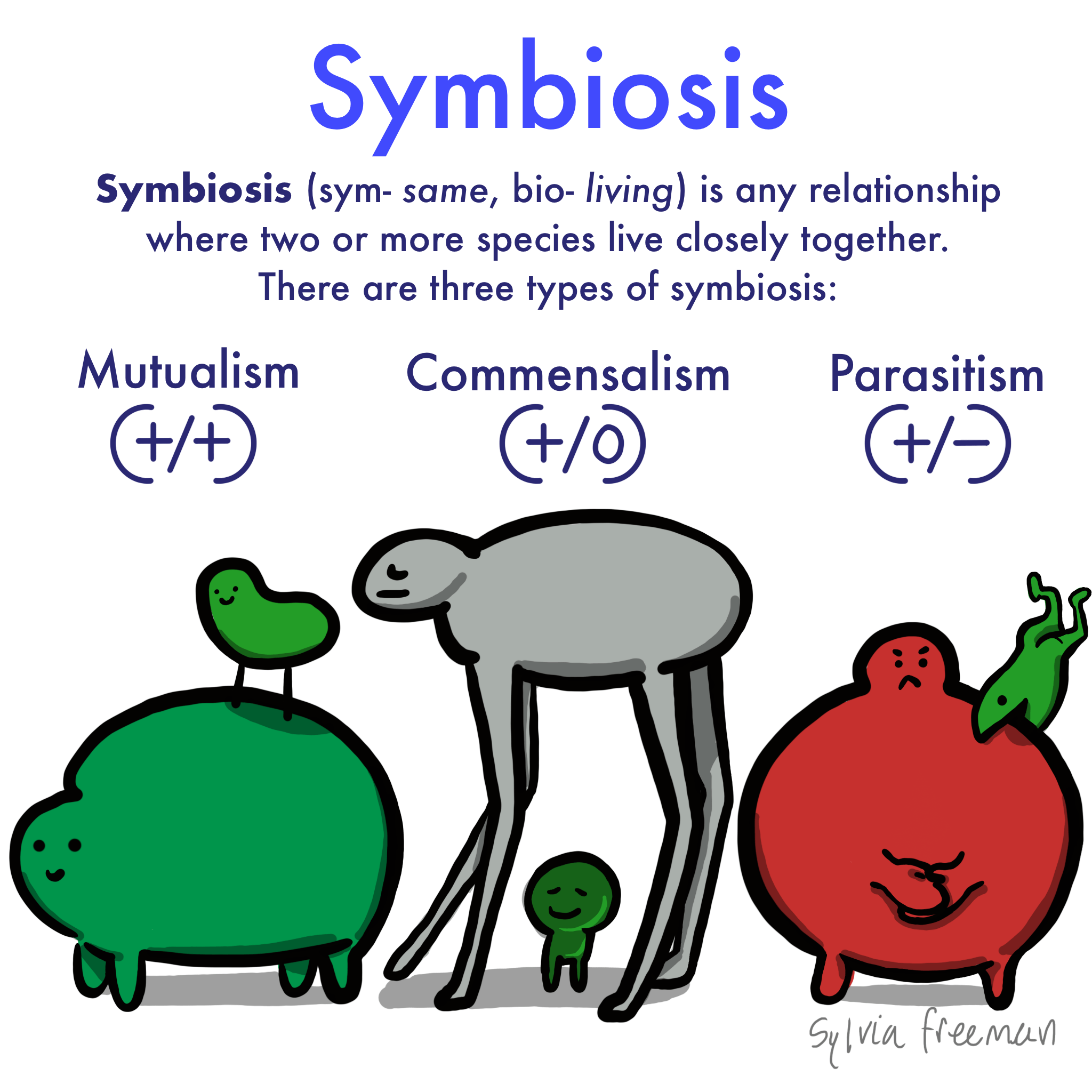There are three basic types of symbiosis. Tap again to see term.

Symbiotic Relationships Common Core Science Living Environment Lessons Symbiotic Relationships
Symbiosis is a close relationship between two species in which at least one species benefits.

. Mutualism - a mutually beneficial symbiotic relationship. Click card to see definition. The definition of symbiosis was a matter of debate for 130 years.
Lichens on a tree. Does not harm or help the other species. There are three basic types of symbiosis.
The three major types of symbiosis are mutualism Commensalism and parasitism. In commensalism only one organism benefits while the other is neither benefited nor harmed. Students will describe the three main types of symbiotic relationships.
The three basic types of are mutualism commensalism and parasitism. The relationship between the other species can be negative positive or neutral. For the other species the relationship may be positive negative or neutral.
A symbiosis definition suggests that it is a relationship where at least one species profits from the other. Each symbiont or community of organisms have to be of a distinct species. In biology symbiosis refers to a close long-term interaction between two different species.
Because different species often inhabit the same spaces and shareor compete forthe same resources they interact in a variety of ways known collectively as symbiosisThere are five main symbiotic relationships. There are three types of behaviours observed in symbiotic relationships namely. In symbiosis the key word is BENEFITS.
But there are many different types of symbiotic relationships. Mutualism commensalism and parasi View the full answer. In mutualistic symbiosis both parties benefit from.
Symbiotic relationship can be of the follow forms. Symbiosis is a close relationship between two or more different species. Or one organism could benefit at the expense of the other Parasitic.
Predation and herbivory - symbiosis where one organism feeds. Commensalism - a one-sided symbiotic relationship. What are three types of symbiosis.
Competition - relationship in which organisms compete for resources. Ad Includes lesson plans worksheets quizzes DIY activities you can do in the classroom. MutualismA relationship where both species benefit from the relationship.
The definition has varied among scientists with some advocating that it should only refer to. Mutualism commensalism and parasitism are the three main categories of symbiosis. There are three basic types of symbiotic relationships.
Planet Earth is inhabited by millions of speciesat least. Parasitism - one species lives on in or with a host species. In 1877 Albert Bernhard Frank used the term symbiosis to describe the mutualistic relationship in lichens.
Find step-by-step Biology solutions and your answer to the following textbook question. Three type of symbiosis are- 1. Franco BanfWaterFrameGetty Images.
Students will define symbiosis. Two different species cannot share the same resource in the same conditions. The struggle of individuals to obtain a shared limiting resource.
Mutualism commensalism and parasitism. Symbiosis is a close relationship between two different kinds of organisms or living things. Made in partnership with the National Science Teaching Association.
Humans and cultivated plants Humans and domesticated. For the other species the relationship may be positive negative or neutral. Mutualism - positive for both organisms.
Click again to see term. Each relationship is defined by how they affect both members of the relationship. Both organisms could benefit from themselves Mutualism.
Mutualism is a type of symbiosis where. In mutualism both the involved organisms benefit from each other. In symbiosis at least one member of the pair benefits from the relationship while the host may also benefit may be unaffected or may be harmed.
Mutualism is when the two species both benefit from the. Symbiosis is an evolutionary adaption in which two species interact in ways that are often related to the survival of one or both participants. Or where one benefits from the other without harming it Commensalism TYPES OF SYMBIOSIS.
The three types of symbiotic relationships is mutualistic commensalistic an parasitic relationship. Tap card to see definition. Organisms may use other organisms for cleaning protection or gathering food.
In 1878 the German mycologist Heinrich Anton de Bary defined it as the living together of unlike organisms. Symbiosis is a relationship that exists between two organisms. There are three types of symbiosis we will discover.
Symbiosis is a close relationship between two species in which at least one species benefits. Mutualism is a close relationship in which both symbiotic partners benefits from the interaction. CommensalismA relationship where one species obtains food or shelter from the other species.
Give an example of each. Mutualism is a symbiotic relationship in which both species benefit. Within a mutualistic relationship both organisms benefit from the symbiotic.
Mutualism Mutualism is the relationship most commonly associated with symbiosis. Three types of symbiotic relationships are mutualism commensalism and parasitism. The most common types of symbiosis include.
There are many different types of symbiotic relationships. Mutualism commensalism predation parasitism and competition.

Symbiosis Lesson Plan A Complete Science Lesson Using The 5e Method Of Instruction Symbiosis Science Lessons Lesson

Symbiotic Relationships English And Spanish Versions Relationship Worksheets Symbiotic Relationships Middle School Science


0 Comments